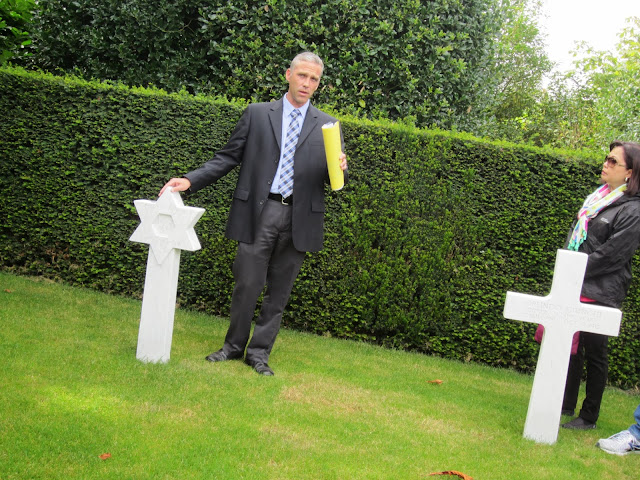Our last stop today was at Flanders Field American Cemetery and Memorial. Hilbren wanted us to see the pristine care the US government provides for its fallen soldiers compared to the other cemeteries. (Those of us who have visited our military cemeteries around the world are already aware--and proud.) This is the only American WWI cemetery in Belgium and 411 American servicemen are buried or commemorated here. Many of them fell during the Ypres-Lys Campaign by the 91st Infantry Division in the closing days of the war.
Administered by the American Battle Monuments Commission, the cemetery occupies a six-acre site. And as with all Allied war cemeteries, the land was provided in perpetuity by the Belgium government. Masses of graceful trees and shrubbery frame the burial area and screen it from passing traffic. At the end of paths leading to three of the cemetery corners are circular retreats with benches and urns.
Chris, the superintendent of the property for the past four years, led us into the visitors' center and explained that this is the smallest of 24 American cemeteries outside the US. It includes 368 buried and 43 listed as missing soldiers, most of whom gave their lives in liberating the soil of Belgium. Families, he told us, could decide to ship their loved ones home or leave them here.
Before leading the visitor center, he also proudly pointed out the photo of Charles Lindbergh's plane flying over the cemetery on May 30, 1927. Not my best photo...
Chris then led us outside to stand among the graves. Showing us two graves next to one another--one with a cross and the other, a Star of David, Chris explained that the two were best friends and the families asked they be buried next to each other. He also told us each gravestone is washed and cleaned every week day.
Headstones throughout the cemetery are aligned in four symmetrical areas around a white stone chapel standing in the center of the cemetery.

The altar inside the chapel is made of black and white Grand Antique marble with draped flags on each side; above it is a crusader's sword outlined in gold. The chapel furniture is made of carved oak, stained black with white veining to harmonize with the altar. The forty-three names of the missing American servicemen are inscribed on the Walls of the Missing; and rosettes mark the names of those since recovered and identified.
It really is a beautiful and peaceful place; and you could tell how proud Chris is to serve his country at this location. After a very busy day, we got back on the bus for the trip back to Bruges.







No comments:
Post a Comment